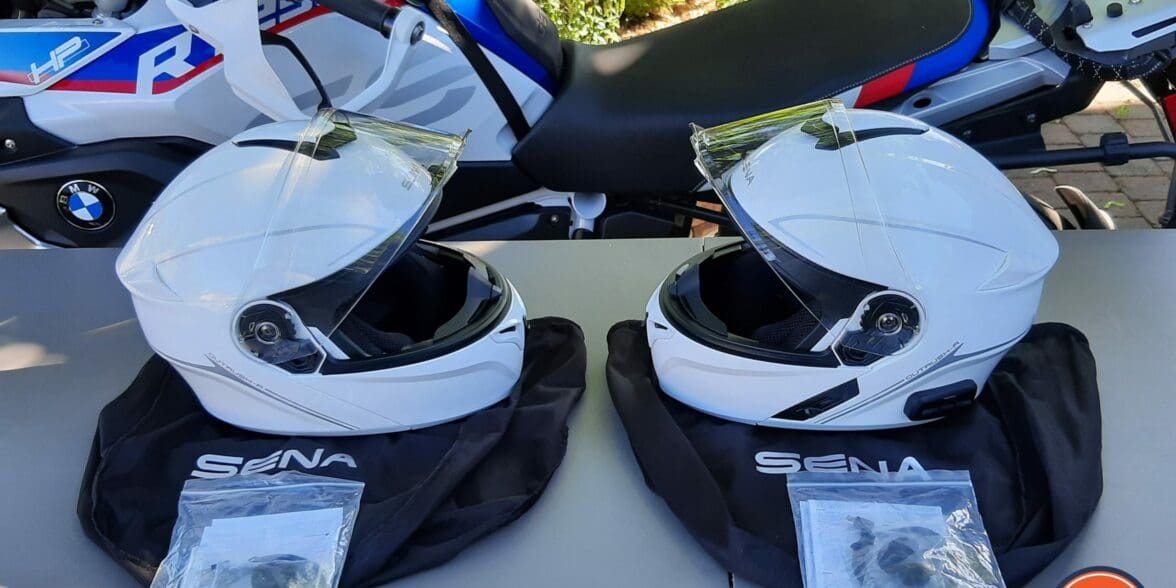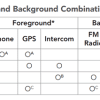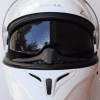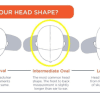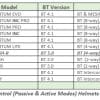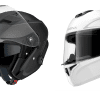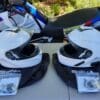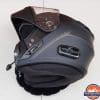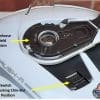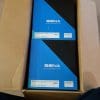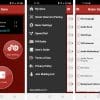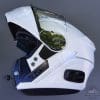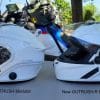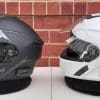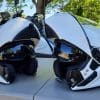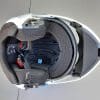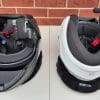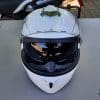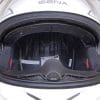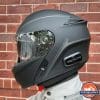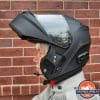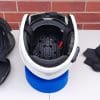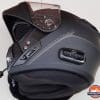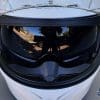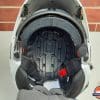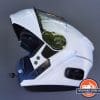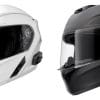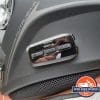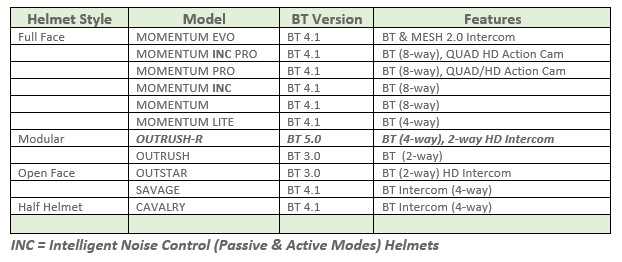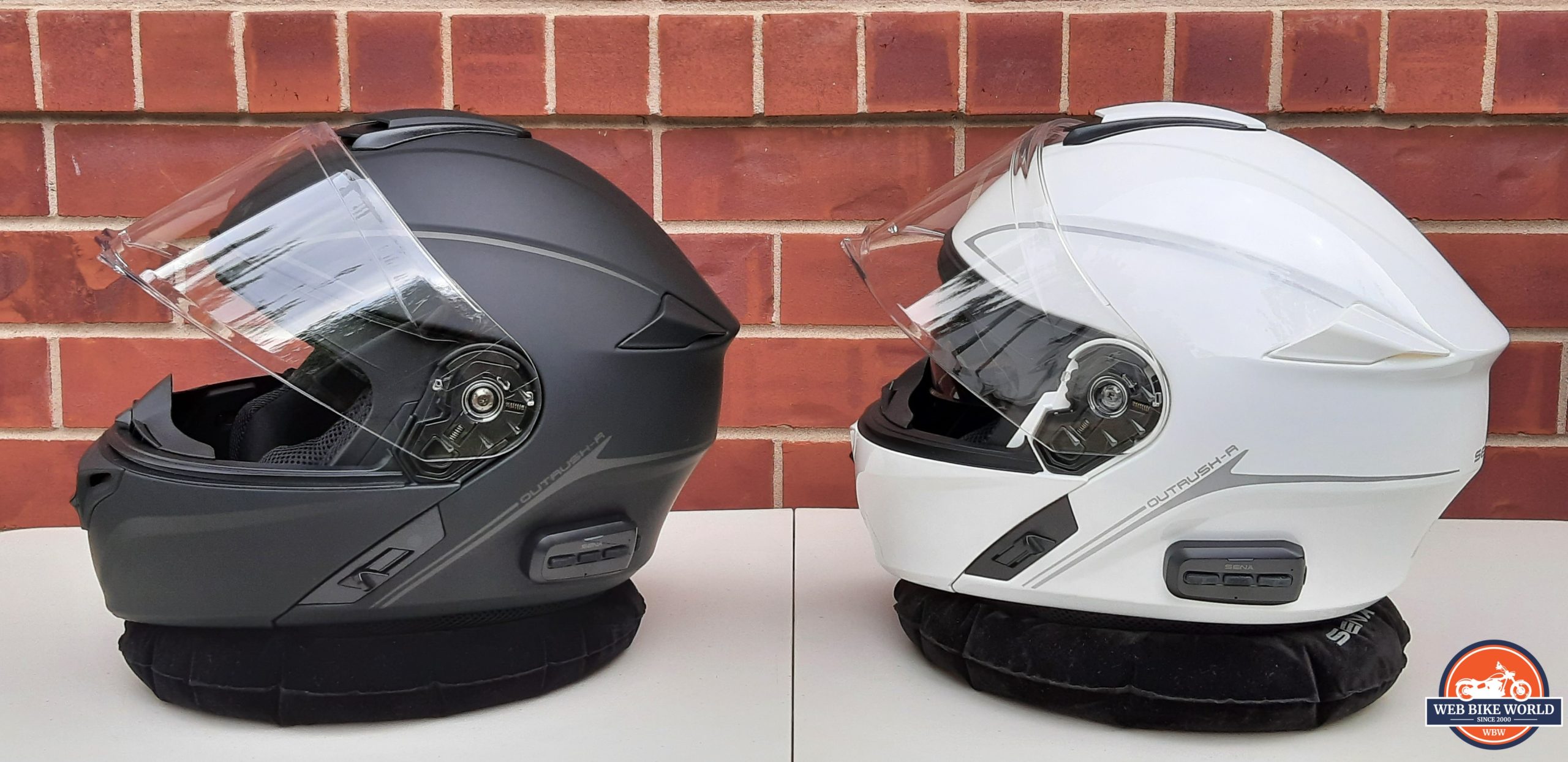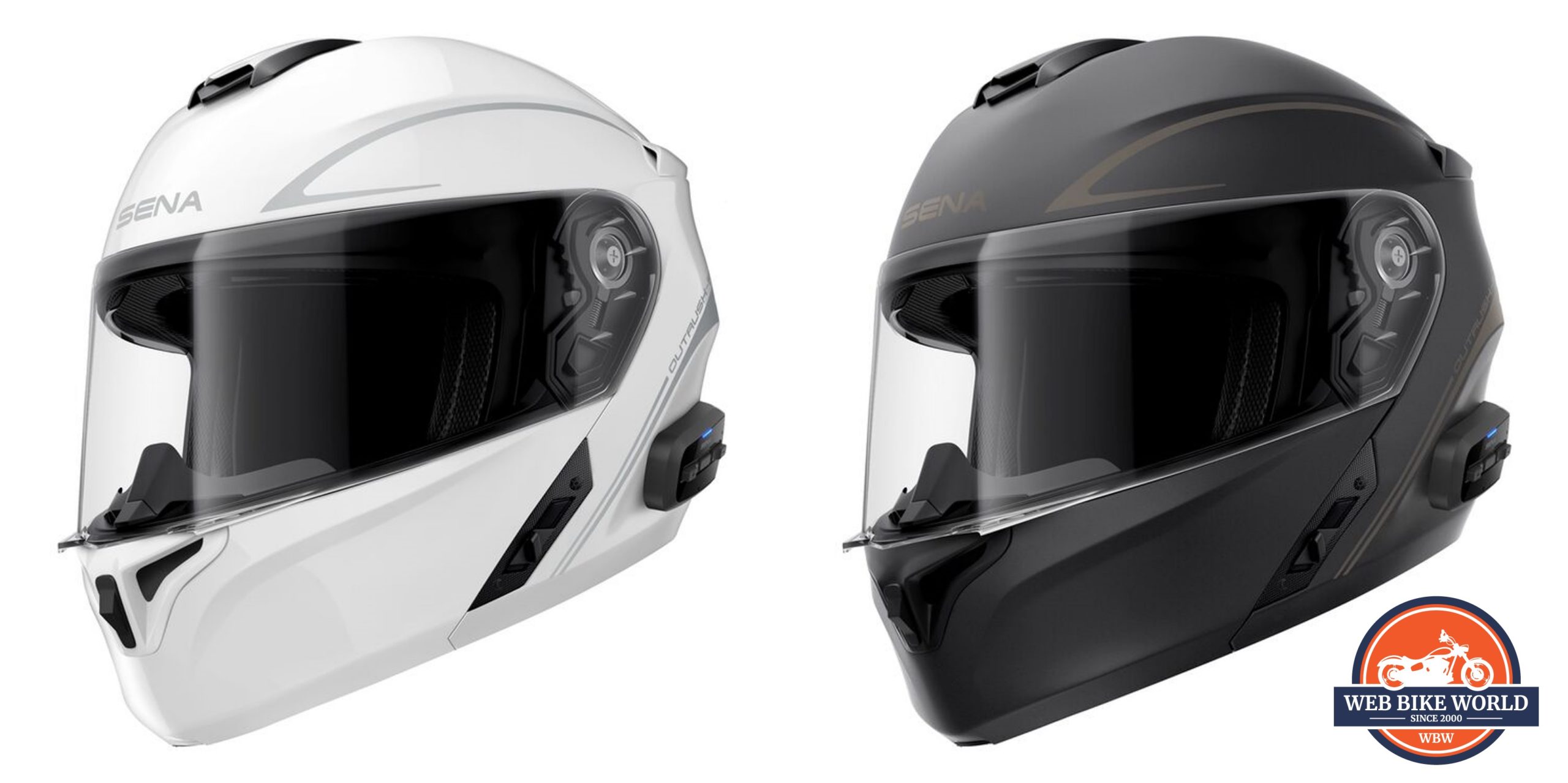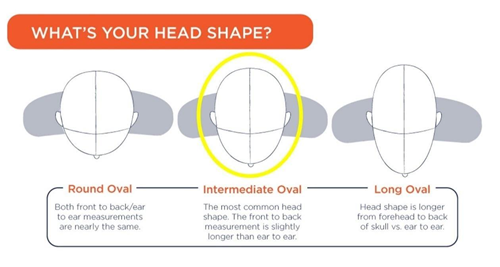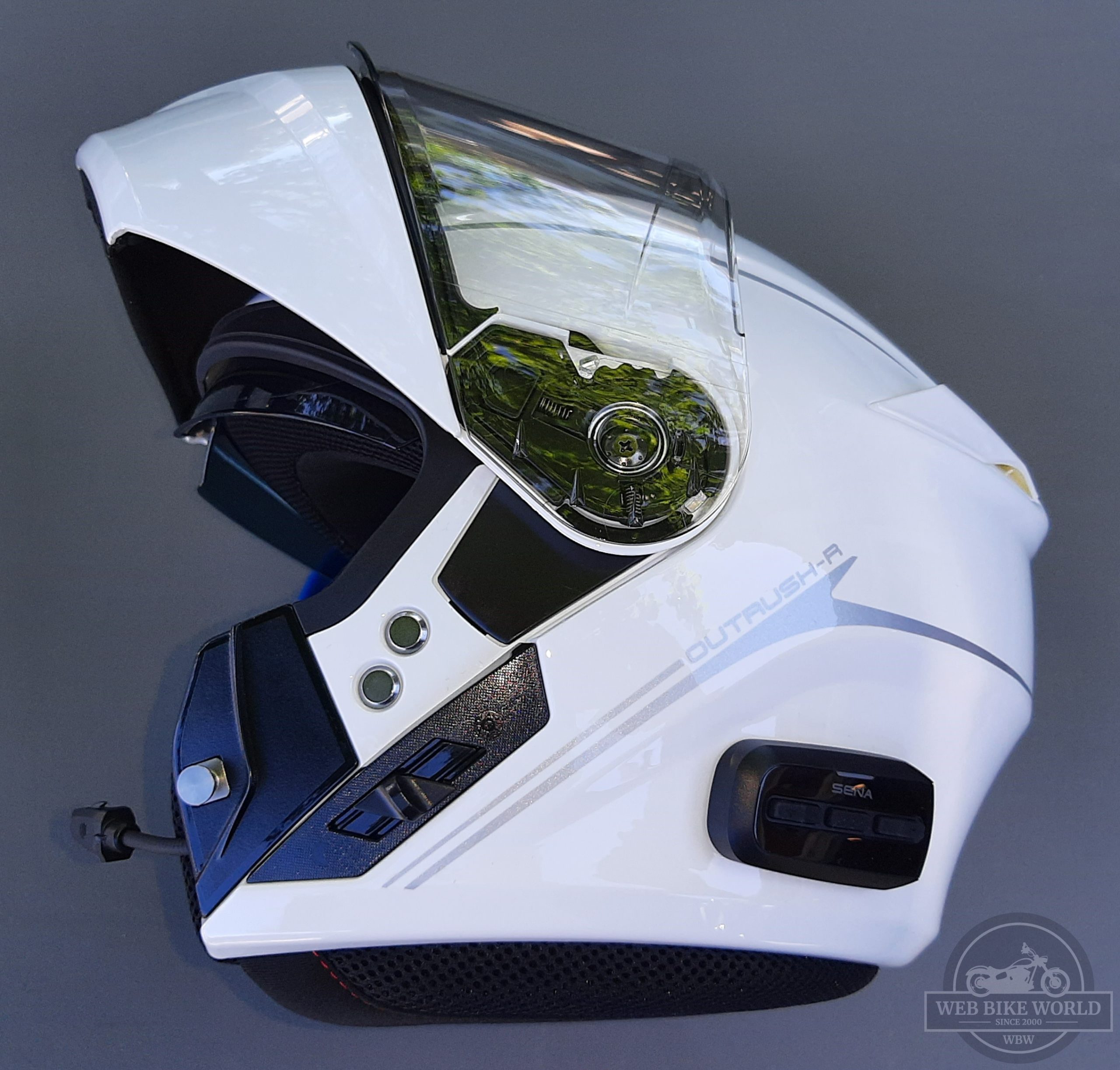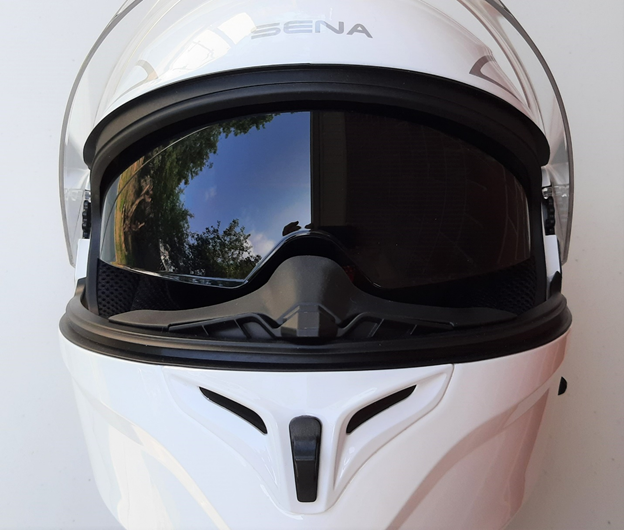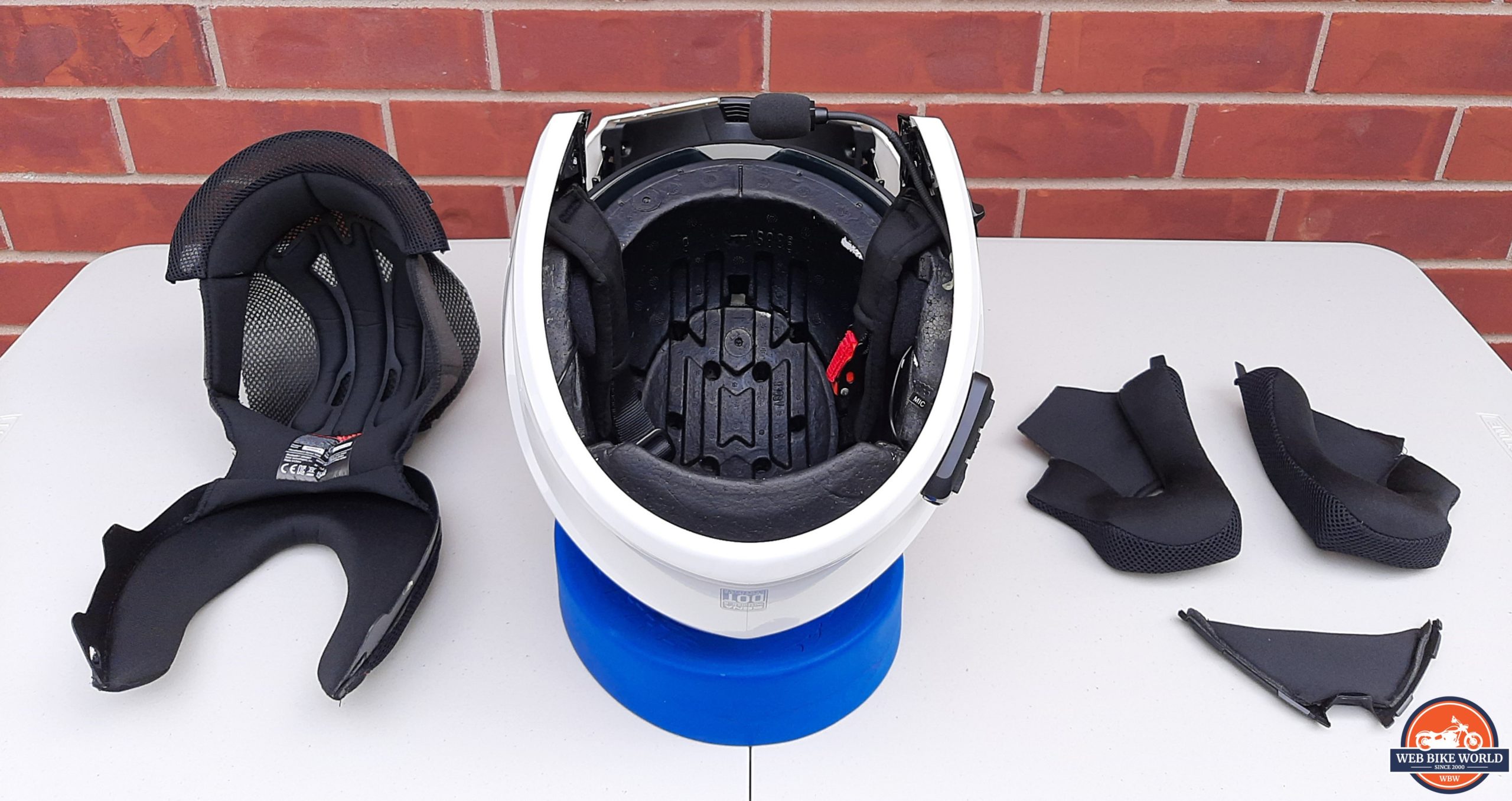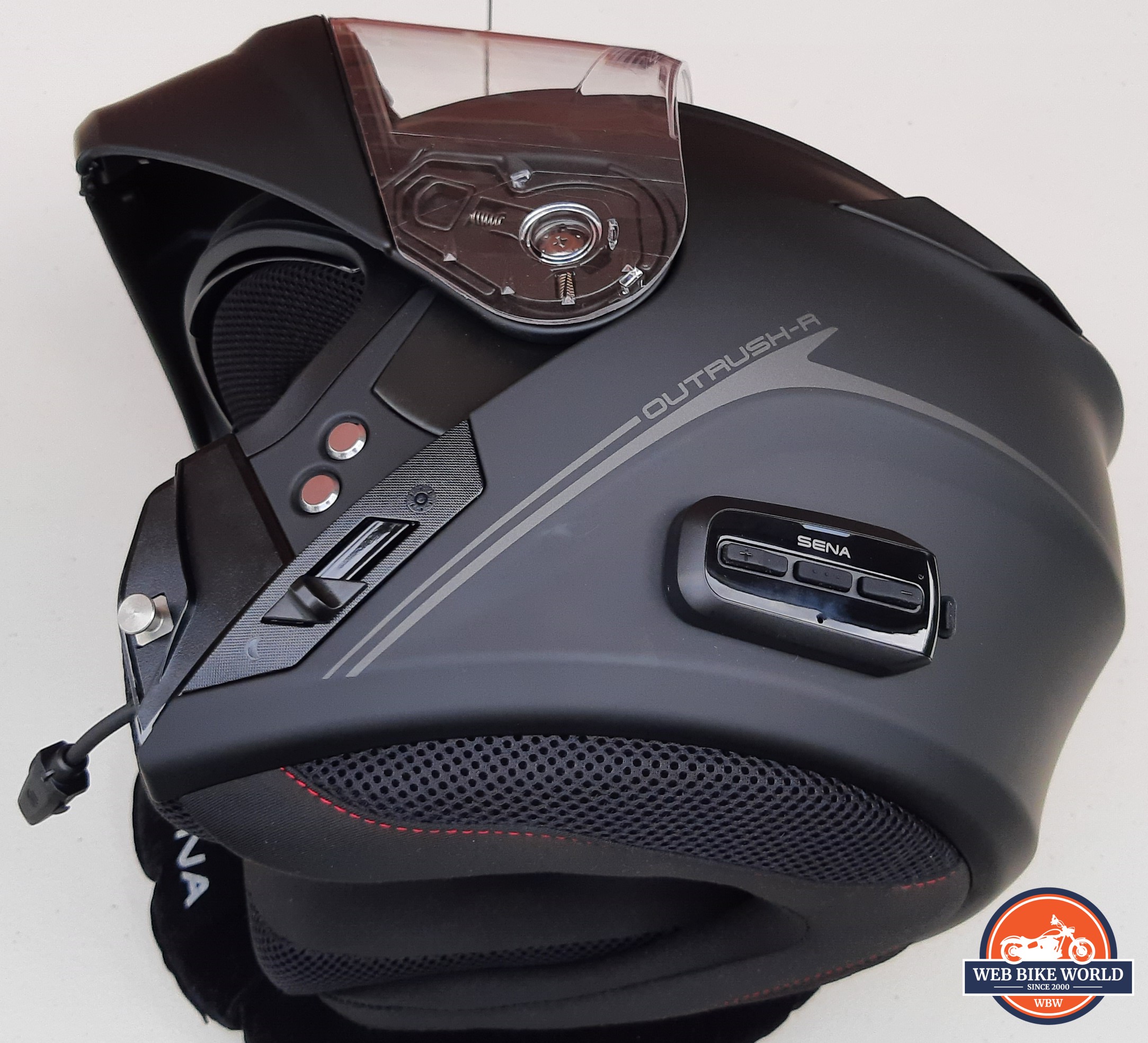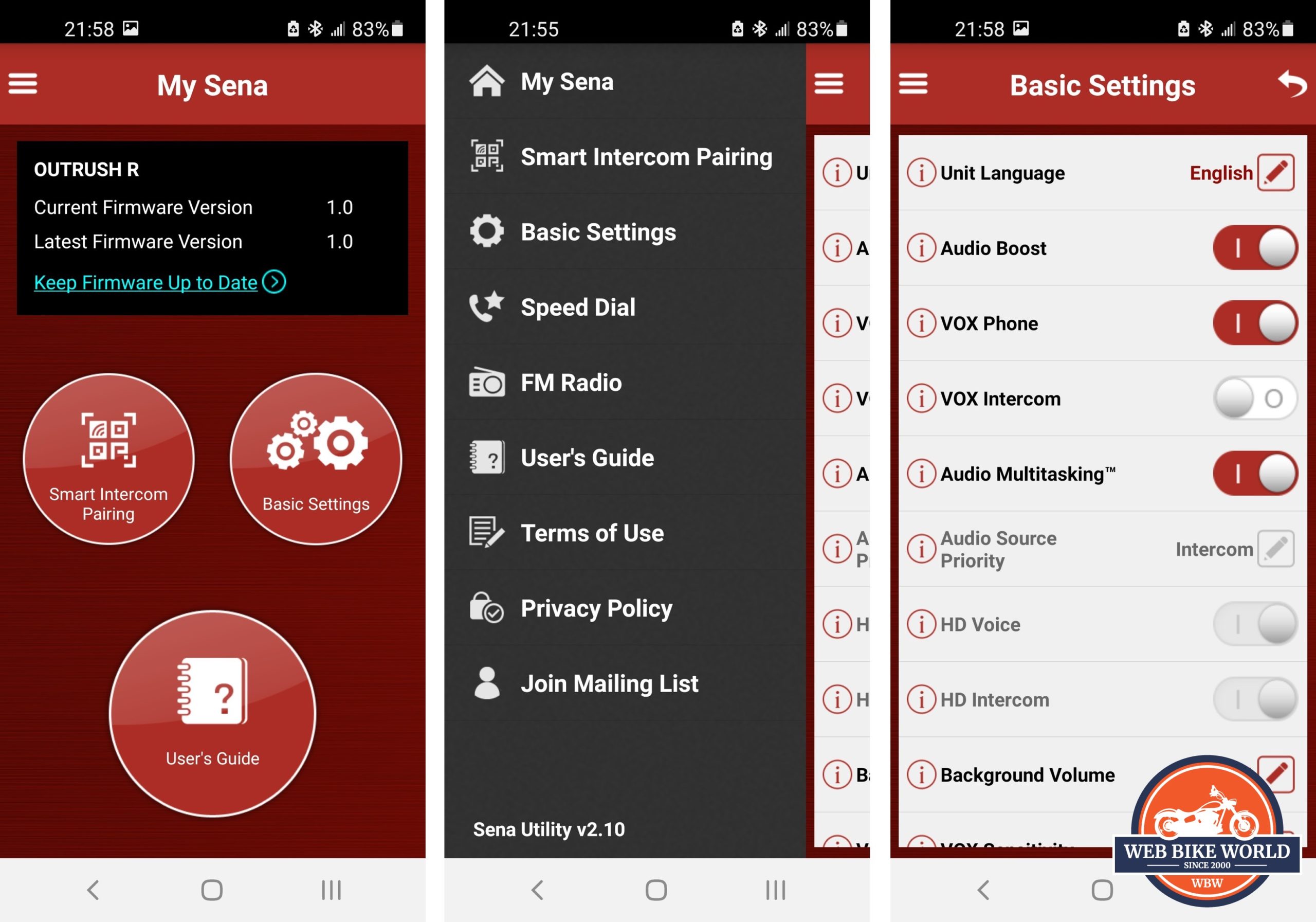Here we are well along another riding season (such as it is given everything else) here north of the one-way (more or less) border, although the restrictions are loosening or being modified; as such, many of us remain semi-contented in riding closer to home, exploring more of the roads (paved or otherwise) and trails while appreciating the scenery and wildlife of our vast country.
Relatedly, in remaining closer to home and not wandering far far away for extended periods of time, the opportunity to slow down just a little and get a better perspective on things has been, overall, a positive thing on many levels…
And from one perspective, there has been a bit more time to get better acquainted with some of the products under wBW review; one of them being the new Sena Outrush R modular Smart Helmet – two of which were received in June.
Why two? Well, because we asked and Sena graciously provided them – one medium and one large, both in Gloss White; it’s always good to have multiple user perspectives especially with personal protective equipment (PPE) pieces like helmets.
But in doing the important first impressions – first charging – first use steps we discovered that the Medium had a functional BT system but mono audio output, in that the left speaker worked fine but it was nada from the right one.
Some cautious inspections of the exterior module and interior layout including the connections didn’t reveal anything – not even any bad-connection-related noises from the right speaker – drats. This is indeed most unusual and the first time in years (decades) of purchasing products and doing product reviews that this issue was an issue…hmm.
The solution of course is to carry on with the one fully functional helmet in Large, while arrangements were made with Kasey at Sena to get the defective unit replaced.
And it was made to be so, with two packages received early August – one with a replacement Outrush R in Medium in Matte Black (fully functional) and the second containing the new Sena Spider RT1 and ST1 MESH headsets.
The Sena Smart Helmet Line
The expanding Sena Smart Helmet lineup for motorcycling use comprises full-face, modular, open-face, and half helmets. The current listing is summarized in the following wBW table:
wBW did a review of the original Sena Outrush in September 2020 and found it to be a great offering although with limited features and a few weaknesses that Sena could easily address.
But overall the original version was deemed a very good investment if looking for a well-priced, well-performing helmet with a well-performing integrated Bluetooth system.
And it seems Sena wants to keep the momentum going regarding the modular Smart Helmet segment with the release of this updated version, now identified as the Outrush R and now powered by Bluetooth 5.0 for significant performance enhancements including updated speakers and audio multitasking.
And in considering compatible products to further enhance the ownership experience, Sena has multiple accessory items available, like the +MESH, FREEWARE, SR10, SM10, POWERPRO MOUNT, and POWERBANK, along with the RC3, RC4, and Wristband Remotes.
First Impressions
In already identifying that two, well actually three helmets were provided for this review, it is understandable that the package received from Sena was larger than usual; just right-sized for the two Outrush R helmet boxes.
Lifting the helmet boxes out of the outer shipping box and then taking each helmet out of its individual box and removing the protective helmet bag reveals how light in weight the Outrush R helmets are; and with subsequent weigh-ins, this feel is validated – more on this below.
Notable Features – large eye port, solid well-sealing face shield, integrated sun visor with perfectly-placed and easily accessed slider control, and the new three-button control module on the left side of the helmet.
Visual changes are minimal – the new tightly fitted three-button BT module has a larger footprint over the single rotatable push-button control on the original Outrush, the accent striping and logos are changed, and while not a totally visual thing, the chin-bar vent slider control is fully functional with a more positive open/closed action.
And as ‘first impressions’ don’t need to be just related to the helmet’s physical form, another important and valued first impression is the fact that the Sena Outrush R is both DOT and ECE certified and also Dual P/J Homologated – providing certified rider protection when the chin bar is fully closed or when it is up (locked) – more on this under Certifications and Ratings.
The Outlook R uses a quick-release ratchet-style retention strap (chin strap) and this piece is a distinctive Red, as is the pull to release tab. The cinch strap section is adjustable for optimal fitment.
Overall First Impressions Rating: 4.5/5
Sena Outrush R Paint, Graphics, & Colorways
Hmm, this is easy; with only two colorways – Matte Black and Gloss White, both finished with identical stylish and well laid out not-very-reflective colored accents, along with the externally fitted insert pieces there are no other choices per se.
Sena has (yet) to venture beyond the single colorway finishes for any of their Smart Helmet offerings – the focus is on functional features and obviously, price point and marketing objectives; but additional colorways or multi-colored graphics would add some real zing and visual highlights to the line. If you are looking for helmets with more visual appeal, check out this article on 15 Helmets with Badass Graphics.
Overall Paint/Graphic/Colorways Rating: 3/5
Sena Outrush R Style, Sizing & Fit
Like the original Outrush Smart Helmet, the new Sena Outrush R Smart Helmet is a modular style full-coverage helmet with an integrated sun visor and integrated Bluetooth system.
It’s not radically styled but it does have a smooth look and feel with its sleek flowing lines, aerodynamic contouring, and well-placed, low profile, and solidly-fitted inserts like the air intakes and exhaust ports and sun-visor slider. Thin minimalist styled accents provide a restrained and simple finishing look.
The almost invisible and smooth functioning chin bar control provides a positive release and locking action and the integrated sun visor control is very well placed and works smoothly with minimal effort.
A new, albeit becoming the standard, low-profile three-button control module for the integrated BT v5.0 system sits on the lower left side, a bit further back than seen with many integrated systems including on modular helmets, but still easy to reach and use.
There is only one shell size. The helmet is classed as Intermediate Oval shaping and it is available in Small, Medium, Large, XL, and 2XL – with the 2XL being a new size offering compared to the original Outrush.
While some observations regarding sizing being a bit small are acknowledged, neither the original Outrush in Large or either the new Outrush R helmets in Medium or Large are off the mark regarding overall fit vis-à-vis the sizing chart.
Both the Medium and Large Outrush R helmets are a comfortable fit for the life-long medium and large heads and outside of the odd slight pressure point or an initial feeling of ‘snugness’, nothing jumps out as a major issue regarding fit and comfort – initially or with continued use.
For eyeglass wearers, full-time or part-time: For corrective purposes or otherwise, the ability to slip a pair of eyeglasses or sun-glasses of some type on and off easily while wearing the helmet or, as can be done with many modulars (an oft-touted benefit), putting the helmet on or taking it off while leaving glasses in place, is an important issue.
As observed with the original version the Outrush R continues to accommodate glasses with sufficient eyeglass temple space allowing glasses to be used with the chin bar open or closed and for the two users here the helmets could be put on or taken off while wearing glasses (with the chin bar full open and/or locked up in place of course).
Overall Style, Sizing & Fit Rating: 4/5
Sena Outrush R Weight & Balance
The Outrush R in Large tips the calibrated scales here at 1737gr or 61.27oz or 3.83lbs, with its integrated BT system, while the Outrush R in Medium comes in at 1713gr, 60.42oz, or 3.78lbs.
Based on the original Outrush in Large, the new Outrush R in Large has lost about 48gr or 1.79oz; not a big chunk, but noticeable, at least when the scales are concerned. This still positions the Outrush and Outrush R models pretty much in the middle regarding modular helmets.
Balance-wise, the Outrush R seems to have a slight bias to the rear; something often found with modular style helmets although to varying degrees. But with the chin bar closed, there is no perceptible or uncomfortable weighing on the neck or shoulders at any time.
When the chin bar is open or locked into the raised position, there is, as expected, transfer of weight and loading on the helmet from air pressure once moving; its one reason why low speeds should be the norm when the chin bar is raised or locked up
Overall Weight & Balance Rating: 4/5
Sena Outrush R Exterior
The single shell is lightweight polycarbonate ABS and its blem-free Matte Black or Gloss White finish is likely to be very durable given that the Gloss White of the original Outrush helmet remains free of any visual dings or scratches with continued use, although the Mattle Black finish may possibly show more wear and tear – we shall see.
Chinbar/Chin Guard)– this key modular helmet component is well-formed, full sealing, and easy to use. Its well-integrated almost invisible one-touch control lever is positive in its action (an outward push) and the well-balanced piece is very easy to raise or lower.
Sturdy steel engagement pins on the front edge of the main shell housing and strong metal engagement ratchets on the chin bar provide a positive locking action between the two pieces; that solid ‘clunk’ is most reassuring and it never fails to engage fully.
As with lighter weight helmets especially those formed of polycarbonates and particularly noticeable with modular style helmets there is (expected) flex along the edges and the Outrush R is no different; but whether the chin bar is locked down or raised, there is no doubt as to its strength and protective abilities.
To lock the chin bar up, locate the small slider (only visible when the chin bar is open) located on the right (not left) side of the helmet shell – push it upward to lock the chin bar in place, push it down to release the lock, allowing the chin bar to be used normally.
Vents – there are two external air intakes and two exhaust ports. The lower intake insert is centered on the chin bar just below the eye port, with a stylized slider control – Up = closed and Down = open, while the stylized intakes sit on either side of the control. It’s low-profile, minimalist in appearance, but quite effective.
On top is found a wide low-profile two-piece intake with two shell ports almost hidden under the lower shaping of the intake insert. The upper section of the insert is a slider control – Forward for closed and Backwards for open.
Small exhaust ports on the left and right backside are almost hidden under their stylized pass-through inserts that channel the air to and over the exhaust ports to help pull or exhaust the internally heated air out.
Sun Visor Control – this control is optimally placed along the lower side of the chin bar/helmet join blending in with helmet lines; its also one of the easiest and most positive sun visor controls used as well – quick easy access and minimal effort up or down and slight positive detentes for either position.
The low profile three-button control BT module is more conspicuous, to degrees than the single multi-function wheel used on the original Outrush, but visually where the intent and function of the single wheel might have been questioned the intent and function of the new module and markings leave little doubt…or should.
Overall Exterior Rating: 4/5
Sena Outrush R Eye Port, Face Shield & Sun Visor
Eye Port – the eye port is 22.5cm (8.85in) across and 11.5cm (4.53in) in height at the widest and highest points for very good peripheral vision and a great overall field of view.
The multi-part pliable seal around the perimeter of the eye port features a thin outer channel wall along the top and a double-channel wall layout along the bottom and with the face shield closed completely a tight insulating, sound-dampening and almost waterproof seal is provided.
A secondary insert between the outer shell and the inner chin bar layer is formed to direct air from the front chin vent up along the inside of the face shield – an action that works extremely well in minimizing and nearly eliminating fogging in damp conditions and/or at lower speeds where air channeling aerodynamics are minimal.
Face Shield – the included clear shield is both scratch and UV resistant and optically perfect over the main surface but less so (as expected) along the thicker upper edge and bottom shaping with its styled ‘lip’ featuring a left and right horizontal platform or tab for quick and easy raising or lowering of the face shield – no fumbling here.
A closer look at the shield ratchet mechanism reveals four settings or steps visible on the front edge of the ratchet, although there is a catch or rest point between the third and fourth (fully closed setting) providing a slight opening when a bit of fresh air is needed for ventilation and to help minimize inner fogging (of shield and glasses).
The Quick Release system is a bit stiff when new but is more compliant with use – taking only seconds to remove or install the shield. To remove – open it fully and while pulling/pushing the spring-loaded finger ratchet levers down, pull the shield outward slightly to lift it off the engagement points on each side.
Installation only adds one additional step – with the shield orientated as when fully open, align the four tabs (hooks) on the face shield with their counterpart inserts on the mechanism, pull the ratchet levers down, and push the shield in so the tabs engage with the inserts, release the levers and make sure the shield is locked in and works properly through its range.
Nose or Breath Guard – this shaped pliable piece is easily removed or replaced as desired and its presence is greatly appreciated, especially by those who ride in cooler climates, including the two testing the Outrush R helmets and it is a great complement to the secondary air-channeling insert identified above.
Sun Visor – the medium tint visor is UV rated, well placed when in use, and works very well at reducing glare without impeding user visibility. The left side slider controls work as well if not better than the one on the original Outrush; the slight detentes at the top and bottom of its motion keep the visor in place whether up or down.
Note – as observed with the original Outrush helmet, there is (still) no provision for a Pinlock insert or nor is there a Pinlock compatible replacement shield.
Overall Eye Port, Face Shield & Sun Visor Rating: 4/5
Sena Outrush R Interior
The (interior) helmet liner is composed of both the shock-absorbing (EPS) layer as well as the comfort liner – be it a single or multi-part, fixed or removable.
EPS Layer – is multi-part and multi-density to provide optimal impact cushioning and support. The pieces fit into the Outrush R shell are well-shaped and well fitted, although there is still some flexing and rubbing between the pieces that does result in some squeaking; not that this is any different from many other modular units as well.
EPS Layer Air Channels – another (positive) observation regarding the EPS layer is its precise forming, and equally precise multiple channels and ports, providing the ways and means to flow lots of air into, through, and out of the helmet.
Helmet Comfort Liner – the lining or comfort zone in the Sena Outrush R is multipart and quite plush overall. The left and right cheeks pads are thick and very supportive but their shaping may not be optimal for everyone, although to be fair, the units here are still adapting to the occupants and some original pressure observations are disappearing.
The cheek pads, marked for the size of the helmet, are easily removed for cleaning or replacement by (gently) but forcefully pulling the three plastic pulls from their liner sockets and pulling the retention straps sections out from their pass-throughs.
Speaker Housings – the speakers are precisely laid into their precisely cut housings in the EPS layer with only a very slight projection due to the foam covers and with the cheek pads in place an insulated audio area is created for each ear; a layout that enhances the audio experience.
Neck Roll/Headpiece – this component combines the bottom cushioning and sealing neck roll along with the multi-layer cushioning headpiece. The top section features a raised padded layer next to the head with a breathable open material layer above – this layout facilitates the circulation of incoming air and wicking of heat and moisture from the head – very effective.
This large one-piece liner section is removable by detaching the inner front sections away from small underside hooks on the front latch pin plates, separating the edges from the lower helmet area, and pulling the upper front or brow section tabs out of their inserts on the EPS liner.
Chin Curtain – a chin curtain, for most helmets is a wonderful thing especially when it’s removable… The Outrush R has a very good chin curtain with a semi-pliable shaped insert section that fits into the lower front of the chin bar and a soft stretchy non-irritating (at least for this rider) panel.
When fitted the chin curtain provides a good seal, greatly reducing bottom air intake for both noise and cold air mitigation and when desired, it is easily pulled off and tucked away in a safe spot (but not lost), allowing bottom air intake for ventilation purposes although with an increase in noise levels around and inside the helmet.
Retention Strap – or chin strap, is the usual two-piece component, but it is the quick release type rather than the double D-ring layout. The longer adjustable cinch strap section is on the right and the shorter ratchet engagement component is on the left. Both the D-ring and Quick Release layouts work, but I find myself leaning towards the one-step Quick Release solution…
Overall Interior Rating: 4/5
Sena Outrush R Aerodynamics & Noise Management
All the users agreed that the Outrush R looks like it should be a well-performing helmet regarding aerodynamics and noise management and the subsequent individual assessments after using the Outrush R revealed that its performance is even better and deserving of an excellent rating regarding overall noise management.
As with the original, the new Outrush R is a bit of a ‘sleeper’ helmet regarding its effectiveness in dealing with riding environments. Its shaping and contouring are very effective in maintaining a smooth airflow to, around, over and beyond the helmet with minimal buffeting – all of which help reduce resultant noise levels around and inside the helmet.
Even the chin guard that so many users discard immediately plays or can play a key role in airflow and noise management. Yes, it can create a much warmer helmet environment in some conditions through reduced airflow into the helmet along the bottom, but it can also provide a much warmer and protective interior as well; keep it close.
Overall Aerodynamics & Noise Management Rating: 4/5
Sena Outrush R Integrated BT System
Overview
The integrated BT system in the Sena Outrush R is powered by Bluetooth v5.0 – a definite upgrade providing functional and performance enhancements including much better battery life.
Endowed with Sena’s mature standardized firmware, the integrated system provides multi-device support with fast pairing, connectivity, and switching for phone calls, music streaming, or other app-based audio, along with a 900m (0.5mi) four-user intercom or two-party HD Intercom.
Other features include FM radio, multi-language (11) Voice Prompt feature, Advanced Noise Control, Smart Volume Control, Smart Intercom Pairing (SIP), and Sena Utility App (iOS or Android) for a standardized look-n-feel user interface.
BT System Form & Fit
Where the original Outrush helmet utilized a single multi-function rotatable push-button control, the Outrush R utilizes a more commonly found low-profile three-button control module providing specific discrete positive switching functionality from each of the controls.
The module measures 6.8cm x 3.4cm x 2.3cm (2.68in x 1.33in x 0.9in) and fits securely onto the left side of the helmet – behind the chin-bar layout and well placed regarding aerodynamics and easy left-hand access while on the move.
Upgraded HD quality speakers are integrated into the left and right ear speaker recesses on hook-n-loop pads and the high sensitivity microphone sits just to the left side of the mouth on a short flex boom.
Sena Device Manager & Sena Utility App Interfaces
Outside of the three-button controls on the face of the module, the user has the ability to connect to and interface with the integrated BT systems by using either the Sena Device Manager using the provided USB Type C connection cable.
The Sena Device Manager is needed for firmware updating, whereas configuration and dynamic management of the system is typically easier in using the UI provided by the Sena Utility App available for iOS and Android smart devices.
Controls & Function
Everything about the integrated BT system is so well covered in the usual comprehensive, and easy-to-use Sena User Guide provided in the kit or available online that only some of the basics along with some specific pairing information is covered in the following sections.
Charging & Battery Status – the small, almost flush-mounted silicone weather cap on the back of the module covers the USB Type-C port, used for charging and firmware updating. The supplied USB Type C or compatible cable should be used, and charging should only be done from a stable 5V USB-based source.
Unlike most of their other newer systems, Sena does not specifically identify that charging should be limited to a 5V/1A draw, but they do identify that any third-party USB charge can be used as long as the charger is approved by recognized authorities. A full charging usually takes right around 2.5hours, as identified in the User Guide.
And like most of their newer smaller or integrated systems, the BT systems cannot be used during charging – the system automatically turns off when connected to a power source – most unfortunate. On the plus side, battery life is very good, although variances will be seen depending on the onboard resources used.
Module Controls – the three input controls on the BT module, front to back (or left to right when viewed) are the Plus (+), Centre, and Minus (-) buttons. The Plus and Minus buttons have higher outer edges, making them easier to locate initially vis-à-vis the Centre button that is lower but of the same height as the inner portions of the Plus and Minus buttons.
Observation – this common height in the center area can be confusing from a tactile perspective; styling is a good thing, but functionality should be first or better balanced – a distinctive shape for each button would be better…especially when medium to heavy gloves are worn.
To turn the system On, press and hold the Plus and Centre buttons for one (1) second; to power Off, press the Plus and Centre buttons.
Volume adjustments for each discrete audio source are set by tapping the Plus or Minus buttons to raise or lower volume; each source set is maintained after the system is shut off.
Device Pairing & Connectivity
Again, like most newer Sena systems and many other new BT devices, the Outrush R system automatically enters device pairing mode whenever it is turned on (press Plus and Centre buttons for 1s) or after a reboot necessitated by a Factory Reset or when the Delete All Pairings action is taken.
When the Outrush R system is already On, press and hold the Centre button for 10s, “Phone Pairing” is heard, put the mobile device in BT pairing mode or scan and select the ‘Sena OUTRUSH R’ when it appears in the listings, often at the bottom as a new device.
To pair other devices, press and hold the Centre button for 15s until “Configuration Menu” is heard, tape the Plus button until “Second Mobile Phone Pairing” or “GPS Pairing’ is heard.
Advanced Selective Pairing that provides the means to selectively pair individual devices for either A2DP Stereo and/or Handsfree Audio connectivity is available. To pair and connect a device for A2DP audio-only, enter the Configuration Menu and tap the Plus button until you hear “Media Selective Pairing”,- complete this process per the initial phone pairing.
For HFP for Phone Call Only (or GPS navigation instructions), step through the Configuration Menu until “Phone Selective Pairing” is heard – now complete this pairing/connectivity as described above.
Intercom Function & Performance
The Outrush R BT system allows up to three other users to be paired for BT intercom use, with the usual daisy-chain serial-based approach used with the ‘Last In, First Out’ (LIFO) or last come, first served approach for connectivity.
The simplest intercom use is between two users as a 1 to 1, but multi-way intercom configurations are also supported in that a three-way or four-way ‘conference’ session is possible – all well described and diagrammed in Section 6 of the User Guide. And whether needed or not, it’s a great way to learn…
One of the best updates from the original Outrush to the Outrush R is the boost in intercom range and performance. While the stated bump from 800m to 900m isn’t a big leap overall performance of the intercom is better – clear audio, less noise, and over relatively flat open ground, that 900m claim can stretch close to 1000m – not a given but it was done.
Using the HD intercom feature between two users work great, although it does impact range and limits the use of other connected devices for audio services – more on this below.
Audio Performance
Remember the statement in the original Outrush review, “The weakest component of the whole BT headset? The speakers.” Well, in having made that statement, I can now state that it definitely does not apply to the new Outrush R.
With Bluetooth v5.0 onboard and related firmware tweaks, virtually everything audio related with the Outrush R is better, and – let’s start with the speakers.
The Speakers – in not knowing exactly which variant or generation of speaker Sena has endowed the Outrush R with there is no ignoring (literally) the difference in output and quality between the original and these new ‘R’ pieces.
It’s not a big ‘WOW’ difference, more like a ‘Wow’; but the audio performance from the Outrush R is truly up a step or two regarding other integrated systems.
AVRCP control of music streaming is much improved – faster and more positive. And users now have Music Sharing between two users, with its unique dual control capability, although some limitations regarding the use of other devices need to be considered in using this feature; but once activated, it works extremely well.
And relatedly, Audio Multitasking (another big plus) is now supported allowing the user to hear audio from two sources simultaneously. When the feature is enabled under Device Manager or the Utility App, phone calls, GPS instructions, and intercom audio can be overlaid with audio from the FM radio, music, or GPS instructions from an app on a smartphone with reduced volume.
The volume of the foreground audio is adjusted using the BT system and the volume of the background audio can be adjusted using settings under the Sena Utility App – specifically the ‘Background Volume setting with its 0 to 9 increments. Note – HD Intercom and Audio Source Priority feature are temporarily disabled when Audio Multitasking is enabled.
The screen snippet below, taken from the Outrush R Users Guide, shows some of the combinations; there are some applicable conditions and restrictions (see Section 12.2.16).
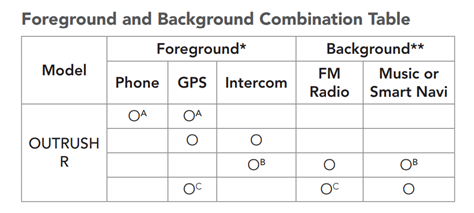

With two helmets and two users assessing the helmet environment of the OUTRUSH R a lot of parallel and some divergent observations were made most pertaining to audio performance.
And while overall volume output could be a bit better to help cope with noisy environments and a bit more oomph in the lower frequencies would be nice, overall audio performance from the Outrush R with its updated BT v5.0 system is much (much) better than that provided by the original version; my playlist is more emotive than ever…
Observation – this big boost in audio performance is most timely and very welcome, and for what it’s worth…this is the type of performance missing from the Sena 3S Plus systems recently reviewed…
Overall BT & Audio Performance Rating: 4.5/5
Certifications & Ratings
DOT (FMVSS No. 218) – the sticker on the back attests to its DOT (FMVSS No. 218 certified) rating for US (and Canadian market products that can have DOT, Snell or ECE).
ECE Certified & Dual Homologated – equally good for the Canadian market and many other markets (it is the most commonly used standard worldwide) is that the Sena Outrush R is ECE rated with Dual P/J Homologation (although this homologation is not seemingly relevant under DOT certification) but it is applicable in the EC and other markets.
This dual homologation means that the helmet has been tested and certified for use as both a full-face helmet (with protective lower face cover like a face shield or approved coverage goggles) – the ‘P’ certification or, as an open-face helmet with superior protection with the chin guard up (locked) – the ‘J’ certification.
Higher standards and dual ratings are a good thing.
Sena Warranty, Support & Accessories
Warranty – Sena offers a 5-year warranty for the helmet and a 2-year warranty for the electronic parts (BT system).
Support: Acknowledging that our support request involved a product provided for review, getting the defective Outrush R helmet replaced was uncomplicated and done expediently – our thanks to Sena for this support. The Sena Outrush R product page is a good starting point for all things Outrush R.
Sena Outrush R Modular Helmet: Concluding Statements
What can I say? Well, for one thing, I can say that the Sena Outrush R Smart Helmet just makes it into the ‘Excellent’ rating category based on input from the two testers instead of the usual one and another rider who used the left-channel-audio-only helmet for a couple of days.
A big contributor to its helmet specific abilities are due to its sleek styling, smooth finish, and effective aerodynamics; the Outrush R helmets look like the original but everything just feels better tuned in these new pieces and the sum of the parts make for a (surprisingly) quiet helmet under virtually all conditions.
Outside of the aforementioned flexing and EPS liner rubbing, the Sena Outrush R is a well-managed environment noise-wise and, surprisingly effective in coping with the elements at virtually any speed in differing cockpits.
Observation (note to Sena) – many other manufacturers have dealt with the shell and chin bar issue along with the multi-part EPS lining sections; can we please address this for the next release?
Overall, the Sena Outrush R helmet is one smooth functioning modular with a well-balanced chin bar and one of the most positive latch/release mechanisms used and, a convenient and smooth functioning slider control for the effective sun visor.
Air intake, helmet ventilation – including up to and around the face shield and face is very good and although the ‘cold’ weather experience is (hopefully) still a few months away (brr), inside air is obviously being pushed/pulled out via the small rear vents as well; moisture buildup, even in our 40+ Celsius heat/humidity, is minimal.
The positive steps and slightly open position provided by the well-fitted face shield is another contributor in managing airflow, noise, and ventilation while on the move; a solid well sealing easy to use face shield and effective sun visor are two less (potential) distractions to deal with. And the face shield does a very good job in keeping the wet stuff out as well.
Helmet audio is very good – as speed and noise build the Advanced Noise Control (enabled by default) goes to work and although its presence isn’t always experienced at lower speeds and in quieter environments it is there and it does reduce ambient noise. The Smart Volume Control setting is also available as a means to better cope with cockpit and helmet environments.
Does or can noise literally overtake helmet audio in some conditions, including speeds not mentionable? Yes, but show me a system that isn’t also impacted to degrees.
This new ‘R’ version hasn’t eliminated all the rough edges, but there are fewer of them and they have been smoothed out for the most part. The new Outrush R does have far more features and far more performance – what’s not to like? Continued evolution with shortened release intervals as we’ve now seen between the original and the Outrush R would be great.
Sena Outrush R: Final Score: 4/5
Sena Outrush R Modular Helmet: Bottom Line
The Sena Outrush R Smart Helmet is a definite improvement over the original version that did have some shortfalls although it was, as observed with other Sena Smart Helmets, a very good first effort and their first modular.
Most of the shortfalls have been expunged from this new version and overall performance, particularly audio, is much (much) better. The price has gone up from 199.99 USD to 259.00, but those 60 bucks are more than returned in features, function, and performance.
The new Sena Outrush R is a very functional well-priced modular that performs as advertised and surprises in a positive way. A close look is highly recommended.
We’ve reviewed a number of other Sena products, such as the 3S Plus Boom, 5S BT, and 10C EVO-01 Bluetooth Systems.
Pros
- Clean aerodynamic lines and effective contouring
- Effective front and top intake and rear exhaust ports
- Smooth functioning well-balanced chin bar
- Solid well-fitting face shield with positive steps
- Sun visor easy to use and effective
- Quick-release face shield and removable sun visor
- New BT system with Bluetooth 5.0, new features, seamless performance
- New 3-button module layout
- Sena firmware support
- Sena Utility App provides a user interface
- Five-year helmet warranty, two years for BT system
- DOT and ECE certified and Dual P/J Homologated
- A better investment than ever.
Cons
- Plastic shell and chin bar sections still squeak a bit (material used)
- No provision for a Pinlock insert or Pinlock equipped shield available
- Accent striping and logos should be reflective or strips (as provided with Euro kits) should be included
wBW Specs
- Product page: SENA Outrush R Helmet
- Price (when tested): $259.00 USD
- Made In: China
- Colors: Matte Black & Gloss White
- Sizes: Small, Medium, Large, XL and 2XL
- Safety Designations: DOT & ECE rated, Dual Homologated P/J Approved
- Warranty: 5-year warranty on Helmet, 2-year warranty on electronics
- Review Period: June – July 2021
- Review Submission Date: 10 August 2021
Important Links / Where to Buy


